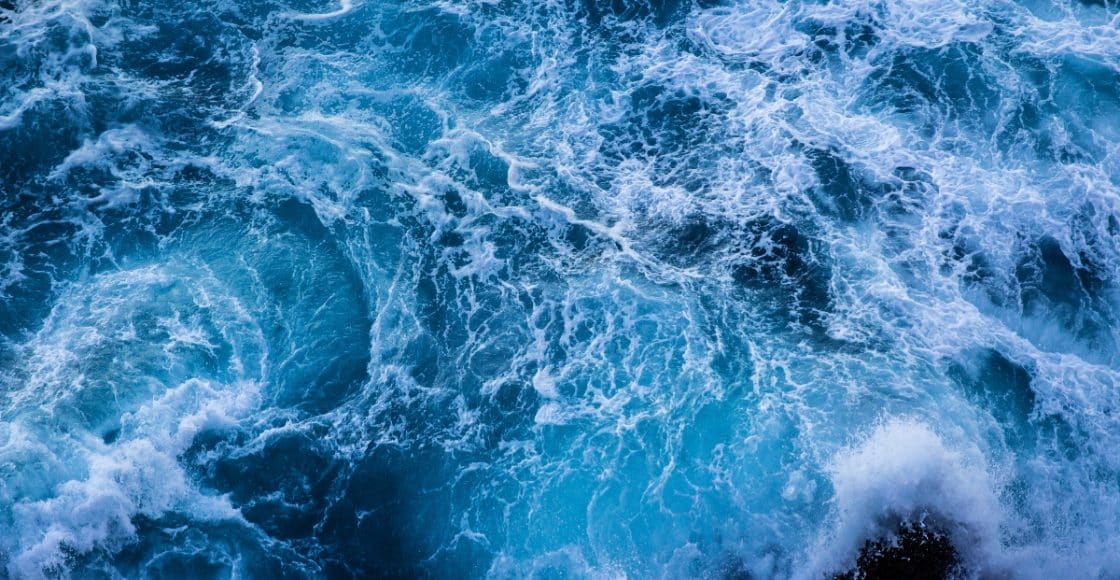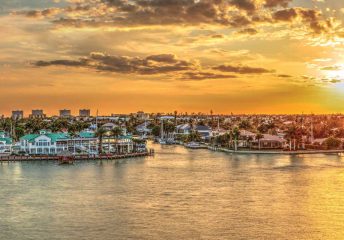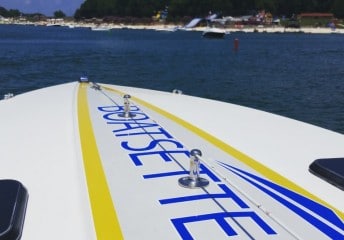Best Boats for Rough Water: 6 Qualities that Make for a Smooth Cruise
Last Updated on December 13, 2023 by Boatsetter Team
Most boats will perform well on calm water but when the sea kicks up, there are a few design elements that ensure a more stable ride. Some of these characteristics are tradeoffs with other features but if you boat on rough, choppy or offshore waters, consider a boat with one or more of the following features. In this post, we’ll highlight the six qualities you’ll want to keep an eye out for when sifting for the best boat:
- Two (or three) hulls
- More deadrise at the forefront
- Stiff heavy hulls
- 4:1 (length-to-beam ratio)
- Center gravity & draft
- Boats with high horsepower
20,000 boat makes & models to browse on Boatsetter
1. Two (or three) hulls
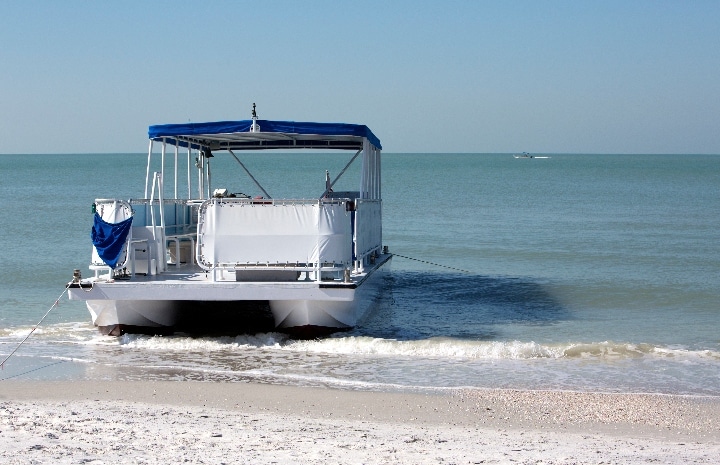
The hull is the portion of your boat that rides both in and on top of the water. Two (or three) hulls are generally more stable than one because they make a beamier (wider) boat. A monohull fishing boat for example, will roll more than the same length power catamaran and that leads to fatigue after just a few hours of angling. Boats with a broader beam tend to be steadier at speed and especially at rest and that makes a world of difference when you’re casting or cruising. Besides, multihulls also offer more deck space to work with so look for multihull models from World Cat, Aspen, Invincible and others.
The benefit of the beam also applies to pontoon boats, especially tritoon (three tube) models that can take a two foot chop in stride. Godfrey, Bennington, Manitou and other builders offer strong boats that can fly across a windy lake with ease.
2. More deadrise at the forefront
Monohull boats with a deep-V or more deadrise at the forefoot will track better and pound less than flat bottom vessels. Deadrise is the angle between the bottom of the hull and a horizontal plane. Optimum angles are 20-24 degrees for a soft ride when going into head seas. Regal, Sea Ray, Sabre and others specialize in building deep-V boats that can venture out in sketchy weather.
Flared or “Carolina” bows also help keep the decks dry. Bow flare will part water spray and toss it to the sides rather than onto the driver so you can go faster in big waves and stay comfortable. Sea Hunt and Skeeter make boats with plenty of flare.
Hulls with a higher freeboard are generally drier than those with lower decks. Freeboard is the distance between the waterline and the gunnel. Rough waters can swamp low vessels like flat boats but higher gunnels provide an extra measure of protection. Yellowfin and Everglades build models that make boaters feel safely ensconced within the boat in big seas.
3. Stiff heavy hulls
It’s no secret that heavier boats ride smoother regardless of the sea state. Displacement boats (rather than those that plane like watersport boats) will part the seas or lift with oncoming waves rather than skitter across and get tossed around by rough water. Stiff, heavy hulls with stringer reinforcement will perform better and stay more stable. Grady White and Boston Whaler are good choices, although the heavier the boat, the more horsepower it takes to move it.
READ MORE: How to Plan for a Boat Trip
4. Length-to-beam ratio (4:1)
Longer waterlines bridge waves better so boats glide rather than bob in a chop or swell. A boat with a length-to-beam ratio of 2:1 will be more difficult to drive than one with a ratio of 4:1. A 40-foot boat with a beam of 10 feet should cut through the water without trouble. Cape Horn and Axopar build boats that slice through water like knives.
5. Center of gravity & draft
The lower the center gravity of a vessel, the more likely it will stay upright with little effect from waves or high winds. Most weight on a boat is provided by the keel, the engine(s), tanks, and batteries, which all act as ballast that stabilizes the craft. Keep in mind heavy T-tops or flybridges raise the center of gravity, so if you’re seasick or unsteady on your feet, steer clear of the highest point on a boat.
A deeper draft also helps keep a boat upright. Displacement hulls with longer and deeper keels are more comfortable in heavy seas than boats with a shoal keel. Passage makers like Nordhavn, Ocean Reef, and Grand Banks are good examples, but they are slow-moving long-distance cruisers rather than planning speedsters.
Pro tip: Renting a boat is a sweet alternative to boat ownership. As a Boatsetter Renter, for example, you find boats by your favorite brands and even boat types such as yachts, sailboats, cruisers, and more!
6. High horsepower
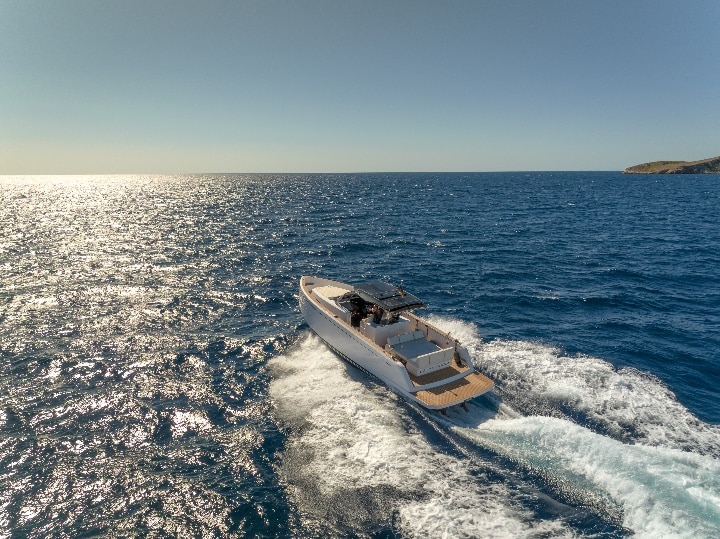
Finally, higher horsepower boats are usually better for rough water because they add weight down low and push through a sea state with more power. If you need to run from a storm or make it to a sheltered anchorage quickly, larger engines are a must. Inboard engines sit low in the hull and outboards add weight to the stern of boats and are kicked around less in following seas. Examples include any boat with multiple outboard or inboard engines.
Buoyancy is key to keeping a boat moving on her lines as much as possible. Self-draining cockpits with scuppers keep the water out of the boat so it doesn’t become weighted down and sluggish. Most open and express boats will have multiple scuppers for safety.
Beyond basic design
The above elements are basic to naval architecture, and all contribute to a safer, more stable vessel. However, don’t forget to look at a boat as a whole. Does it have shock-absorbent seating at least for the driver? Does it have a good windshield and cabin protection? Are there adequate handholds along the entire length so you can move forward and aft safely in a seaway? Assess the seaworthiness of a boat using many variables before heading out in rough water.
About us
Boatsetter is the go-to app for boat rentals and on-water experiences. Whatever the adventure, we’ve got a boat for that—Set sail, start the party, go yachting, make your trophy catch, and hone your watersports skills! Download the Boatsetter app (App Store | Google Play). Make sure to follow @boatsetter on Instagram, and tag us in all your boat day pictures for the chance to be featured.
Rent. List. Share—Only at Boatsetter

Zuzana Prochazka is an award-winning freelance journalist and photographer with regular contributions to more than a dozen sailing and powerboating magazines and online publications including Southern Boating, SEA, Latitudes & Attitudes and SAIL. She is SAIL magazines Charter Editor and the Executive Director of Boating Writers International. Zuzana serves as judge for SAIL’s Best Boats awards and for Europe’s Best of Boats in Berlin.
A USCG 100 Ton Master, Zuzana founded and manages a flotilla charter organization called Zescapes that takes guests adventure sailing at destinations worldwide.
Zuzana has lived in Europe, Africa and the United States and has traveled extensively in South America, the islands of the South Pacific and Mexico.
